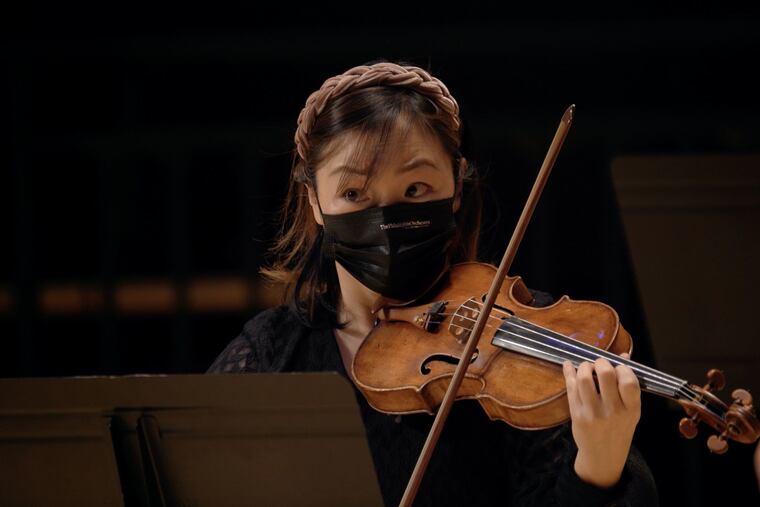A Haydn for Holy Week is part of another intriguing Philadelphia Orchestra digital program
“La Passione” joins Elgar's "Serenade for Strings" and Caroline Shaw’s "Entr’acte" on this week's program.

By luck or design, the Philadelphia Orchestra has assembled a concert program of pieces that hail from radically different times and places but somehow sound, in this week’s digital program starting 8 p.m. Thursday, as if they could be family.
Obviously, Bach’s massive St. Matthew Passion isn’t in the cards for this socially distanced Easter season, but music director Yannick Nézet-Séguin believes that Haydn’s Symphony No. 49, “La Passione,” is indeed informed by the passion of Christ, both in its character and in its Holy Week performance history, with stabbing rhythms and minor keys in place of the composer’s usual rustic humor.
Elgar’s similar rhythmic edge almost sounds borrowed from Wagner’s Das Rheingold in his Serenade for Strings, while Caroline Shaw’s Entr’acte intentionally adopted a Haydn-esque veneer but one with parallels in Elgar’s Victorian poise.
These aren’t wise, cultivated masterpieces but works by major composers still finding their ultimate compositional voices. (Elgar, for one, sounds as if he forgot to write a needed final movement.) Though perhaps too small-scale to turn up regularly in Philadelphia Orchestra concerts, these pieces couldn’t be more welcome now with the orchestra reduced in size and spaced evenly on the Verizon Hall stage.
“Like recalling fragments of an old tune or story” reads one of the performance directions of Shaw’s Entr’acte, written about a decade ago originally for string quartet. Every generation defines neoclassicism differently, and this piece is a series of modules, each with a distinct manner, often punctuated by memory hiccups. You think you’re hearing a church hymn until the strands of counterpoint start tripping all over each other and unravel. Scratching sounds suggest that the players are repairing their instruments. (They aren’t.)
Other fascinating modules include an insistent pizzicato rhythm with long, lyrical lines that don’t know what they’re saying or where they’re going, but are doing so insistently. Also intruding is a Philip Glass-style minimalist episode. A lesser composer might be bewildering with such fragmentation. But Shaw is charmingly baffling. This orchestra played the tricky rhythms valiantly, probably counting out the beats rather than feeling their meaning. I look forward to their next outing with the piece.
If Elgar’s best-known works feel like a warm bath, the Serenade for Strings is a lukewarm one, but with a middle movement — beautifully rendered by the Philadelphia strings — showing how the composer would later emerge. It seems to capture a beautiful moment in time, tinged with a sad, nostalgic knowledge that all things pass. Gustav Mahler was feeling many of the same things at the same time in central Europe. But Mahler was a more interesting renegade in contrast to god-and-country Elgar. And maybe that’s why Elgar’s piece isn’t played so much.
Dating from 1768, Haydn’s Symphony No. 49 is a quarter-century ahead of his ultimate masterpieces in that medium, and it projects the sense of exploring roads less traveled in terms of what a symphony could be — the first two movements, for example, sound like they should be switched. So the symphony starts in a slow, dark, searching mode, and Nézet-Séguin seems to hear it in a spirit similar to Haydn’s Last Seven Words of Christ, a more explicit Holy Week piece that seeks not to please but to contemplate religious mysteries.
Other conductors have taken the symphony into even more personal realms: Soprano/conductor Barbara Hannigan makes “La Passione” a precursor to Mahler, and uses Luigi Nono’s modernistic Djamila Boupachà (about a tortured freedom fighter) as a prelude.
Nézet-Séguin remains pretty faithful to Haydn, with the orchestra working hard to maintain vital tempos in later movements. The presence of a harpsichord (played by Elliot Figg) gives the piece a sense of foundation that some musicologists might deem historically inappropriate. But the instrument is decorated with Old World-style painting that’s a visual treat in this video performance.
The digital “La Passione” concert will be available on demand from 8 p.m. April 1 to 11 p.m. April 8. Tickets are $15-$17. philorch.org.